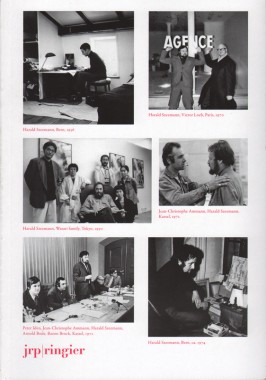
Harald Szeemann, Individual Methodology
Softcover, 240 pp., offset 2/1, 160 x 230 mm
Edition of 2000
ISBN 9783905829099
Published by JRP|Ringier
$25.00 ·
We owe our idea of the contemporary exhibition to Harald Szeemann — the first of the jet-setting international curators. From 1961 to 1969, he was Curator of the Kunsthalle Bern, where in 1968 he had the foresight to give Christo and Jeanne-Claude the opportunity to wrap the entire museum building. Szeemann’s groundbreaking 1969 exhibition When Attitudes Become Form, also at the Kunsthalle, introduced European audiences to artists like Joseph Beuys, Eva Hesse, Richard Serra and Lawrence Weiner. It also introduced the now-commonplace practice of curating an exhibition around a theme. Since Szeemann’s death in 2005, there has been research underway at his archive in Tessin, Switzerland. An invaluable resource, this volume provides access to previously unpublished plans, documents and photographs from the archive, along with important essays by Hal Foster and Jean-Marc Poinsot. There is also an informative interview with Tobia Bezzola — curator at the Kunsthauz Zurich and Szeemann’s collaborator for many years. Two of Szeemann’s most ambitious exhibitions are presented as case studies: Documenta V (1972) and L’Autre, the 4th Lyon Biennial (1997). A biography, an illustrated chronology of Szeemann’s exhibitions and a selection of his writings complete this exhaustive survey.
Art, Criticism, DAP, Florence Derieux, Hal Foster, Harald Szeemann, Jean-Marc Poinsot, JRP|Ringier, Theory, Tobia Bezzola
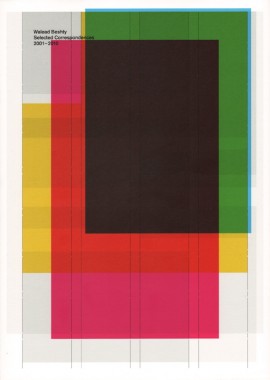
Walead Beshty, Selected Correspondences 2001-2010
Softcover, 128 pp., offset 4/1, 210 x 297 mm
Edition of 2000
ISBN 978-88-6208-135-1
Published by Damiani
$49.00 ·
In 2001, Walead Beshty began documenting the Diplomatic Mission of the Republic of Iraq to the former German Democratic Republic in Berlin. Still protected as sovereign territory under the Vienna Conventions, the embassy has stood abandoned since the early 1990s as, in Beshty’s words, “a relic of two bygone regimes, unclaimable by any nation; a physical location marooned (by) symbolic shifts in global politics, a ruin set apart neitherby fences nor by millennia, but by the invisible and abstract mechanisms of international law”. The site inspired his ongoing engagement with the invisible and marginal territories of globalization which provide an important line through his photographic and sculptural work of the past decade. Selected Correspondences focuses on three bodies of photographic work — two that deal with the Embassy directly and a third, Transparencies, which continues the question of place and movement. The work has been exhibited at the Hammer Museum in Los Angeles, Tate Britain, London, and the Whitney Museum of American Art in New York, among others, and is brought together here for the first time, accompanied by two new essays on the projects.
Art, Criticism, Damiani, DAP, Eric Schwab, Hammer Museum, Iraq, Jason Smith, Peter Eleey, Photography, Tate Museum, Walead Beshty, Whitney Museum, Writings
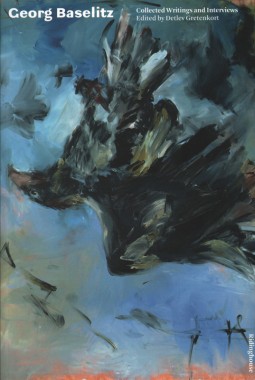
Detlev Gretenkort and Karsten Schubert, Georg Baselitz: Collected Writings and Interviews
Softcover, 300 pp., offset 4/1, 145 x 215 mm
Edition of 2000
ISBN 978-1-905464-23-4
Published by Ridinghouse
$49.00 ·
The outstanding British publisher Ridinghouse brings out the most comprehensive look into the life and work of German abstract expressionist Georg Baselitz. The book is divided into four sections: personal images; a record of Baselitz’s artworks; the artist’s own writings (some published for the first time, many never before translated into English); and interviews with the artist by noted writers and art historians. Known for his rebellious approach to painting, Baselitz discusses the act of painting, his biography and much more. The artist’s writings cover topics from his first trip abroad to other painters he’s admired. Though not a catalogue raisonné, this copiously illustrated book gives the most complete picture ever of a seminal artist.
Art, Criticism, Detlev Gretenkort, Fiona Elliott, Georg Baselitz, Interviews, Jill Lloyd, Karsten Schubert, Louisa Green, Mark Thomson, RAM, Ridinghouse, Theory, Writings
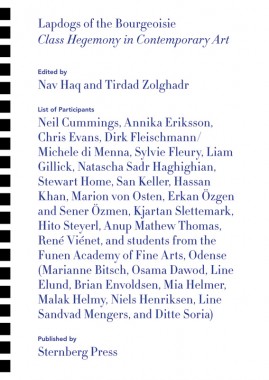
Nav Haq and Tirdad Zolghadr, Lapdogs of the Bourgeoisie
Softcover, 180 pp., offset 4/1, 170 x 240 mm
Edition of 2000
ISBN 978-1-933128-88-7
Published by Sternberg Press
$25.00 ·
Class inevitably raises awkward questions for the protagonists of contemporary art — about their backgrounds, patrons and ideological proclivities. Lapdogs of the Bourgeoisie investigates this latent yet easily overlooked issue, which has been historically eclipsed by gender, sexuality, ethnicity and nationality. This book creates a conversation on a sensitive subject, bringing together essays by art-world types including artists, curators and critics. On one hand, the ideas here raise the question of whether a given socio-economic background still helps define an artistic career — and to which point this career might reflect or consolidate the hierarchies in question. On the other hand, the project asks whether the traditional ways of analyzing class structure are actually helpful in an examination of who makes art today.
Amanda Beech, Annika Eriksson, Anup Mathew Thomas, Arnolfini, Art, Charlotte Bydler, Chris Evans, Criticism, Dirk Fleischmann, Fatham Adel, Gasworks, Hassan Khan, Karim Abo El Fath, Liam Gillick, Malcolm Quinn, Marion von Osten, Michele di Menna, Natascha Sadr Haghighian, Neil Cummings, Platform Garanti, RAM, San Keller, Sternberg Press, Suhail Malik, Tensta Konsthall, Townhouse Gallery, Wessal Abd El Aziz, Zak Kyes
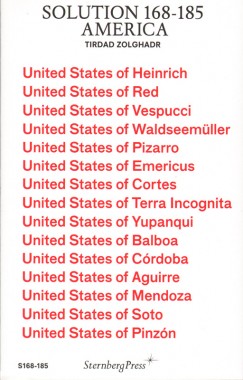
Tirdad Zolghadr, Solution 168-185: America
Softcover, 112 pp., offset 2/1, 110 x 180 mm
Edition of 2000
ISBN 978-1-933128-90-0
Published by Sternberg Press
$19.00 ·
Solution 168–185: America is the fourth book in the Solution series. Opting for the United States of America, “still the most proficiently colonial place I know,” Zolghadr provides a compilation of highly entertaining “solutions,” where the objective is not the education of America so much as the pleasure of a text that purports to be just that. Tirdad Zolghadr is a writer/curator based in Berlin. He is editor-at-large for Cabinet magazine. He organized the United Arab Emirates pavilion, Venice Biennale 2009, and the long-term project Lapdogs of the Bourgeoisie (with Nav Haq). Zolghadr teaches at the Center for Curatorial Studies, Bard College.
Art, Criticism, Ingo Niermann, Kari Rittenbach, Matthew Evans, RAM, Solution, Sternberg Press, Theory, Tirdad Zolghadr, Zak Kyes
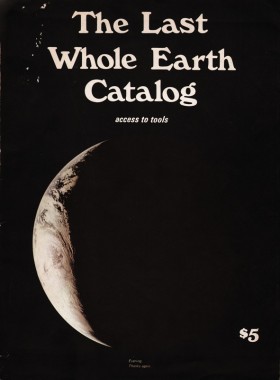
Stewart Brand, The Last Whole Earth Catalog
Softcover, 452 pp., web offset 1/1, 10.75 x 14.25 inches
First edition (1971)
ISBN 0-394-70459-20
Published by Portola Institute
$55.00 · out of stock
condition:
good, edge wear, worn cover/spine, interior discolored, very good reference copy.
We can’t put it together. It is together.
The Whole Earth Catalog is an American counterculture catalog published by Stewart Brand between 1968 and 1972, and occasionally thereafter, until 1998. Although the WECs listed all sorts of products for sale (clothing, books, tools, machines, seeds — things useful for a creative or self-sustainable lifestyle), the Whole Earth Catalogs themselves did not sell any of the products. Instead the vendors and their prices were listed right alongside with the items.
The title Whole Earth Catalog came from a previous project of Stewart Brand. In 1966, he initiated a public campaign to have NASA release the then-rumored satellite photo of the sphere of Earth as seen from space, the first image of the “Whole Earth.” He thought the image might be a powerful symbol, evoking a sense of shared destiny and adaptive strategies from people. The Stanford-educated Brand, a biologist with strong artistic and social interests, believed that there was a groundswell of commitment to thoroughly renovating American industrial society along ecologically and socially just lines, whatever they might prove to be.
Function
The Whole Earth Catalog functions as an evaluation and access device. With it, the user should know better what is worth getting and where and how to do the getting. An item is listed in the Catalog if it is deemed:
1. Useful as a tool
2. Relevant to independent education
3. High quality or low cost
4. Not already common knowledge
5. Easily available by mail
Catalog listings are continually revised according to the experience and suggestions of Catalog users and staff.
Purpose
We are as gods and might as well get good at it. So far, remotely done power and glory — as via government, big business, formal education, church — has succeeded to the point where gross defects obscure actual gains. In response to this dilemma and to these gains a realm of intimate, personal power is developing — power of the individual to conduct his own education, find his own inspiration, shape his own environment, and share his adventure with whoever is interested. Tools that aid this process are sought and promoted by The Whole Earth Catalog.
Agriculture, Architecture, Art, California, Criticism, Culture, Don Gerrard, Earth, Education, Eleanor Watkins, Larry Kline, Les Rosen, Mitzi O'Dell, Nancy Wirth, NASA, Portola Institute, Richard Raymond, Stewart Brand, Survival, Used, Vern John, Whole Earth Catalogue
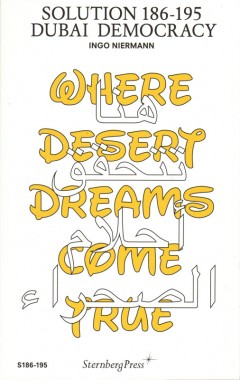
Ingo Niermann, Solution 186-195: Dubai Democracy
Softcover, 128 pp., offset 3/1, 110 x 180 mm
Edition of 2000
ISBN 978-1-934105-17-7
Published by Sternberg Press
$19.00 · out of stock
Using Dubai as a sort of modernist blank slate for urban and social renewal, author Ingo Niermann — a relentlessly creative artist whose tongue is firmly jammed into his cheek — confronts today’s most relevant cultural and technological developments with elixirs that are as pertinent as they are unbelievable. In the fifth book in the Solution series, Niermann sees Dubai, a sparsely populated piece of desert, become specialized as housing the global center for treating diabetes, called
Sugar World. And the Gulf state will be Kumbaya-style universal, too, offering non-confrontational public spaces where both a state of total advertising and compulsive kindness, or what he calls a “personal humaneness account,” co-exist.
“Ingo Niermann is the author and brain behind some of the most intriguing and bizarre intellectual speculations of the last years.”
—Fabrizio Gallanti, Abitare
Architecture, Art, Criticism, Culture, Fabrizio Gallanti, Ingo Niermann, RAM, Solution, Sternberg Press, Theory, Zak Keyes
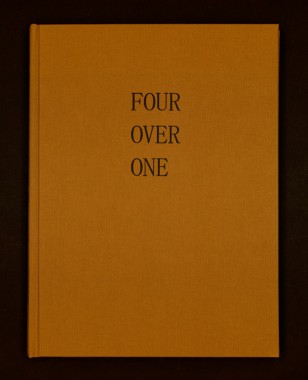
Phil Chang, Four Over One
Hardcover, 64 pp., offset 4/1, 240 x 320 mm
Edition of 500
ISBN 978-087588720-4-9
Published by LACMA
$39.00 ·
In
Four Over One, the Los Angeles based artist
Phil Chang employs the format of an artists book to explore ideas of economy and obsolescence. In collaboration with designer Jonathan Maghen,
Four Over One is structured around Chang’s interest in how new outcomes arise from an antagonism between perceived and actual forms of value. The photographs that appear in the book were created using expired photographic materials exposed by an archival book scanner. Through a sparse display of color, black and white, and half-tone photographs, in conjunction with a restrained typographic treatment,
Four Over One employs an economy of scale in order to consider the roles of abstraction, methods of art production, and modes of distribution in our contemporary culture.
Artforum 500 Words.
Art, Charlotte Cotton, Criticism, Culture, Jonathan Maghen, LACMA, Phil Chang, Photography, RAM, Textfield, Typography, Wallis Annenberg Photography Department
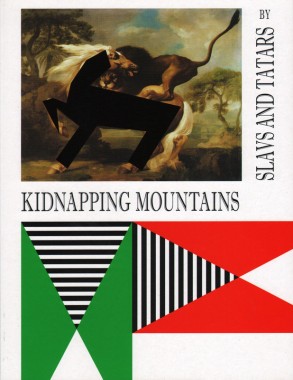
Slavs and Tatars, Kidnapping Mountains
Softcover, 96 pp., offset 4/1, 20 x 26 cm
Edition of 1250
ISBN 978-1-906012-19-9
Published by Book Works
$32.00 ·
Kidnapping Mountains is a playful and informative exploration of the muscular stories, wills, and defeat inhabiting the Caucasus region. The book is comprised of two parts: an eponymous section addressing the complexity of languages and identities on the fault line of Eurasia, and Steppe by Steppe Romantics, a restoration of the region’s seemingly reactionary approaches to romance.
Art, Book Works, Boy Vereecken, Criticism, Culture, Gerrie van Noord, Graphics, Jane Rolo, Kasia Korczak, Payam Sharifi, RAM, Slavs and Tatars, Typography, Victoria Camblin
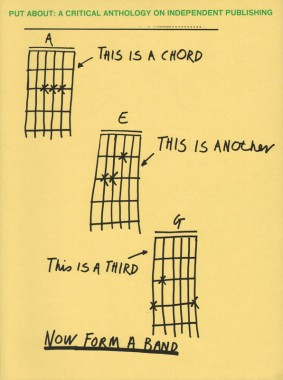
Maria Fusco and Ian Hunt, Put About: A Critical Anthology on Independent Publishing
Softcover, 194 pp., offset 4/1, 190 x 255 mm
Edition of 2000
ISBN: 1-870699-70-X
Published by Book Works
$40.00 · out of stock
Put About: A Critical Anthology on Independent Publishing presents a timely discussion about independent publishing and publishing by artists, focusing on books where the makers keep control of every aspect of production through to distribution. Combining an interest in what and why publishers and artists feel compelled to deliver such materials, together with the economic models, audience and networks of association that can give independent productions a wider cultural presence, this book features a broad range of written and visual pieces alongside ‘case-studies’ from a selection of contemporary international publishers. Contributors include: John Baldessari, Simon Bedwell, Michael Bracewell, Andrea Brady, Cabinet Magazine, Bonnie Camplin, Maurizio Cattelan, David Dibosa, Matthew Higgs, Stewart Home, Lucy Lippard, Emily King, Gunilla Klingberg, Jakob Kolding, John Miller, Paul D. Miller aka Dj Spooky, Aleksandra Mir, Stéphanie Moisdon, David Osbaldeston, Raymond Pettibon, Lynne Tillman, Nicolas Trembley, and Axel John Wieder.
Aleksandra Mir, Andrea Brady, Art, Axel John Wieder, Bonnie Camplin, Book Works, Cabinet Magazine, Criticism, David Dibosa, David Osbaldeston, Emily King, Gunilla Klingberg, Ian Hunt, Jakob Kolding, John Baldessari, John Miller, Lucy Lippard, Lynne Tillman, Maria Fusco, Matthew Higgs, Maurizio Cattelan, Michael Bracewell, Nicolas Trembley, RAM, Raymond Pettibon, Simon Bedwell, Stéphanie Moisdon, Stewart Home, Stuart Bailey
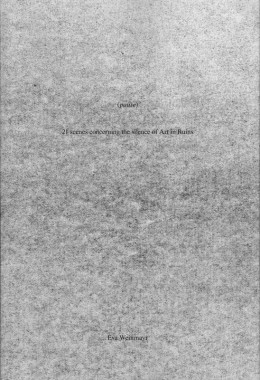
Eva Weinmayr, (pause) 21 scenes concerning the silence of Art in Ruins
Softcover, 72 pp., offset 1/1, 210 x 297 mm
Edition of 500
ISBN 978-0-9562605-4-3
Published by Occasional Papers
$16.00 ·
Why did Art in Ruins, a once prominent art collective, suddenly fall off the art world map? Did they run out of ideas, move on to other territories or simply withdraw in disgust? During brief lulls in their frenetic peregrinations around the glittering international art circuit, a loose group of artists, curators, critics and other art professionals discuss the mysterious disappearance of Art in Ruins, maintaining a sober tone of inquiry even as they encounter herds of bison, anomalous Richard Serra walls and security personnel steeped in art theory. Using actual dialogue from interviews with art professionals who knew Art in Ruins, Eva Weinmayr constructs a hypothetical play as an anti-documentary or anti-biography.
Art, Criticism, Distribution, Eva Weinmayr, Fiction, Occasional Papers, Richard Serra, Sara De Bondt, Theory, Zacheta National Gallery of Art
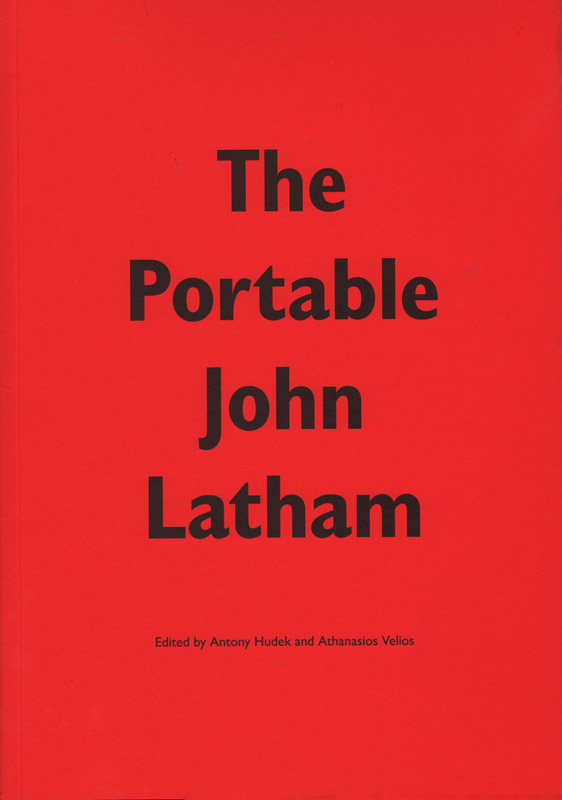
Antony Hudek and Athanasios Velios, The Portable John Latham
Softcover, 112 pp., offset 2/1, 170 x 250 mm
Edition of 1000
ISBN 978-0-9562605-5-0
Published by Occasional Papers
$22.00 ·
This book features a selection of documents from the personal archive of the late British artist John Latham (more information
here), presently maintained in his last home and studio in Peckham, South London. Through reproductions of letters, invitation cards, exhibition reviews, performance scripts and images, the publication retraces Latham’s pioneering practice over six decades, from the late 1940s to his death in 2006. Published on the occasion of
John Latham: Anarchive in association with Whitechapel Gallery, the book also includes an interview by Charles Harrison from 1968 and a glossary section.
Edited and introduced by Antony Hudek and Athanasios Velios.
In the painting and sculpture for which he is best known, Latham’s primary materials included glass, books, canvas and the spray gun. Developing alongside this concise visual language, from the mid-1950s onwards, was a cosmological theory, formulated through his art-making discoveries, that considered time and event to be more primary than the established means of understanding, based on space and matter. Termed Time-Base Theory (sometimes Flat Time Theory or Event Theory) it offers an ordering and unification of all events in the universe, including human actions, and allows an understanding of the special status of the artist in society.
Latham looked at the way in which human knowledge has become fragmented over time; split by divergent religions, ideologies and world-views. He identified the way in which the fields of science and art, despite emerging from a common root, have become separate and operate in isolation of one another: even within a field such as physics, there exist a large number of schisms and specialisations that further fragment our knowledge and understanding of the universe. John believed that this endless division would eventually lead to a kind of entropy and from that state, to a disintegration of society.
Antony Hudek, Art, Athanasios Velios, Charles Harrison, Criticism, Culture, Distribution, John Latham, Occasional Papers, Sara De Bondt, Science, Theory, Typography
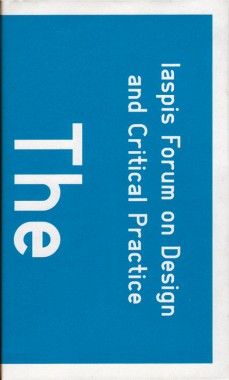
Iaspis Forum on Design and Critical Practice — The Reader
Softcover, 445 pp., offset 4/1, 125 x 210 mm
English and Swedish
Edition of 1000
ISBN 978-1-933128-63-4
Published by Sternberg Press and Iaspis
$25.00 · out of stock
What happens when you look at design as something more than a service-based relationship between client and designer? What new strategies and models help to question and challenge the limits of design? The second publication from the Swedish design think-tank Iaspis, this idea-packed reader focuses on investigative, speculative, and critically oriented design, especially how design relates to architecture. Inspired by an exhibition produced by the Architectural Association in London, the reader is based on four conversations between graphic designers about various aspects of design relating to their practices. It also contains a number of interviews and other texts linked to these conversations, and a broader discussion about design and transboundary practice.
Abake, Art, Criticism, Dexter Sinister, Experimental Jetset, Iaspis, Jonas Williamsson, Magnus Ericson, Mark Owens, Martin Frostner, Practise, RAM, Sara Teleman, Sternberg Press, Will Holder, Zak Kyes












